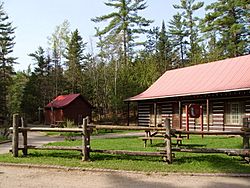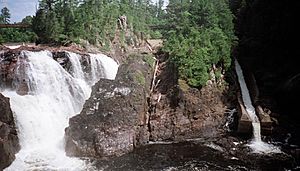Coulonge Chutes facts for kids
Quick facts for kids Chutes Coulonge |
|
|---|---|
 |
|
| Location | Fort-Coulonge, Quebec |
The Chutes Coulonge (pronounced "shoot coo-lonj") is a super fun park in western Quebec, Canada. It's a special place where you can explore history and enjoy nature. The park is famous for its amazing waterfall, called the Grandes Chutes, which is about 42 meters (138 feet) high! There's also a really long cement log slide, about 100 meters (328 feet) long.
Even though people stopped floating logs down the river in 1982, the waterfalls and the deep gorge are still very popular. Many tourists, hikers, and cyclists visit the park. It's a great example of ecotourism, showing how nature can be enjoyed and protected.
Contents
A Look Back: The History of Chutes Coulonge
Early Days of Logging
Long ago, at the start of the 1800s, people used to cut down huge white pine trees. These trees were squared off with axes and then floated down the Ottawa River. They were sold in auctions near the Canadian Parliament buildings. Many of these logs were sent to England to build ships. Timber from this area also helped build big cities like Boston and New York City in the United States.
George Bryson and the River
In the 1830s and 1840s, a man named George Bryson Sr. moved near the Coulonge River. This river flows into the Ottawa River. Bryson bought many acres of land with timber rights. This included about 200 acres (0.8 square kilometers) right around the Grandes Chutes waterfall. In 1843, Bryson even built a famous bridge called the Marchand covered bridge.
As more families arrived from places like Ireland, Scotland, and Germany, many small towns grew along the river.
Building the Log Slide
Around 1850, Bryson built a sawmill by the river. The Coulonge Falls were a huge problem for moving logs. To get around this, a massive wooden log slide was built. It was about 3,000 feet (914 meters) long! This slide helped logs pass safely over the dangerous waterfall. In 1923, a new, stronger cement slide replaced the old wooden one. Another sawmill, built by J.E. Boyle in Davidson, is still working today. It sends wood to the United States and other parts of Canada.
The Coulonge River and its log slide were used for floating logs until 1982. A few years later, in 1985, the site became a public park. A special building for visitors was opened, and people have been enjoying the park ever since!
See also
 In Spanish: Cataratas Coulonge para niños
In Spanish: Cataratas Coulonge para niños


